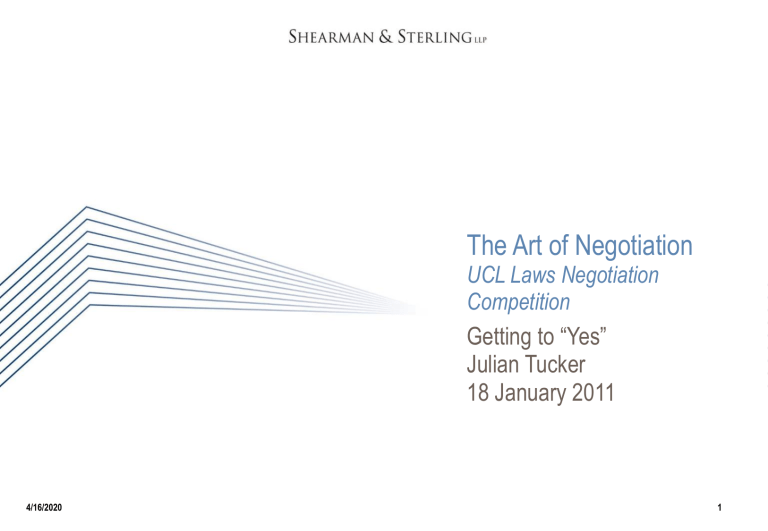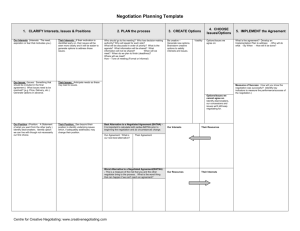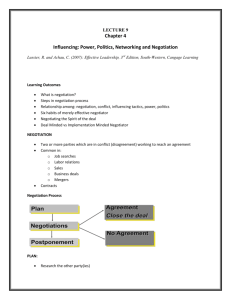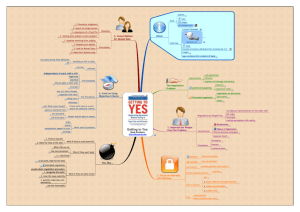The Art of Negotiation Getting to “Yes” Julian Tucker 18 January 2011

4/16/2020
The Art of Negotiation
UCL Laws Negotiation
Competition
Getting to “Yes”
Julian Tucker
18 January 2011
1
The Art of Negotiation
Purpose
To provide participant with an overview of what good practice negotiations looks like.
4/16/2020
Copyright © 2005 Shearman & Sterling LLP. As used herein “Shearman & Sterling” refers to Shearman & Sterling LLP, a limited liability partnership organized under the laws of the State of Delaware.
2
The Art of Negotiation
Outputs
By the end of this short presentation participants will:
be introduced to the different styles of negotiation understand the types of approaches a negotiator can take be aware of the skills required to be an effective negotiator pick up some tools, tips and techniques which they can apply in the negotiation game.
4/16/2020
Copyright © 2005 Shearman & Sterling LLP. As used herein “Shearman & Sterling” refers to Shearman & Sterling LLP, a limited liability partnership organized under the laws of the State of Delaware.
3
4/16/2020
The Art of Negotiation
Negotiation – a definition:
“A discussion in order to reach an agreement.”
Oxford English Dictionary
4
4/16/2020
The Art of Negotiation
The Competitive Style
The Cooperative Style
5
4/16/2020
Negotiation – the Competitive style
Characteristics:
Open with high demands
Take strong/specific position
Reveal little information
No empathy
Argumentative rather than conciliatory
Narrow issues for negotiation
6
4/16/2020
Negotiation – the Competitive style
Purpose of Competitive negotiator:
To obtain concessions while make few concessions
7
4/16/2020
Negotiation – the Competitive style
Advantages
Useful against a weak opponent
Strengths derived from clear and limited objectives
Technique respected by clients
A ‘good result’ can be achieved early
Enables negotiator to be clear and consistent
Disadvantages
Produces tension
Generates mistrust and irritation
May lengthen process
Exacerbates differences
May focus on trivial issues
8
4/16/2020
Negotiation – the Cooperative style
Characteristics
The Cooperative negotiator aims to:
Put the client first
Be fair
Maintain good relations
Look for common ground between parties
Make reasonable offers to settlement
Create an open and trusting environment
9
4/16/2020
Negotiation – the Cooperative style
Advantages
High probability of reaching settlement
Fairness is normally achieved
It encourages concessions from other side
Has potential to offer greatest benefits to both parties
Easier to enforce
Disadvantages
Cooperative approach can be mistaken for weakness
Opponent may take advantage of cooperation
Concession may be made too readily
Pressure easily applied by opponents
Hard to control – not tightly focussed
10
4/16/2020
Negotiation Approaches
The Positional approach
The Problem Solving approach
11
4/16/2020
Negotiation Approaches
The Positional approach
The favoured approach for the competitive negotiator
Three step approach:
First step: determine bottom line
Second step: ascertain your opening position
Third step: negotiate
12
4/16/2020
Negotiation Approaches
The Problem Solving approach
Centres on all angles of the case
All factors considered
Primary objective is to maximise gains all round
Most effective in the hands of experienced negotiators
13
4/16/2020
The Skills of an Effective Negotiator
Questioning and listening skills
Trustworthy
Personable
Perceptive
Self controlled
Prepared
Legally astute
Realism
Convincing
14
4/16/2020
The Art of Negotiation
Tips
Try to separate the people from the problem
Focus on interests not on positions
Invent options for mutual gain
Insist on objective criteria
Always develop a best alternative to a negotiated settlement (BATNA)
15
4/16/2020
The Art of Negotiation
Any Questions?
16







